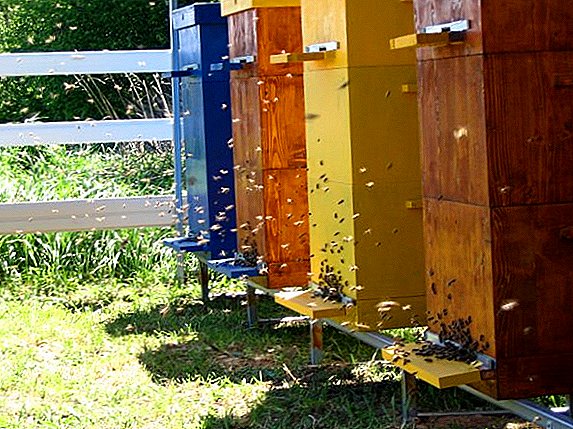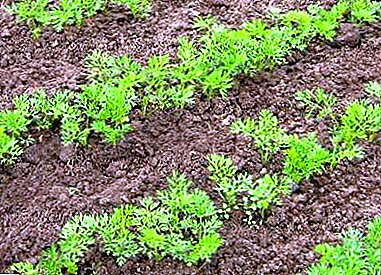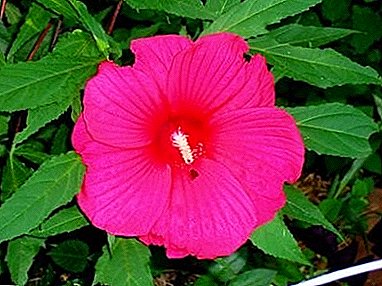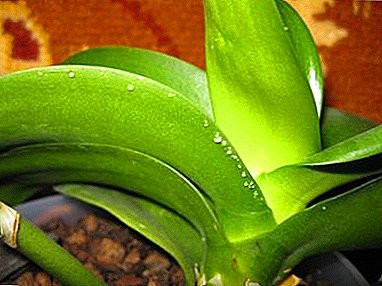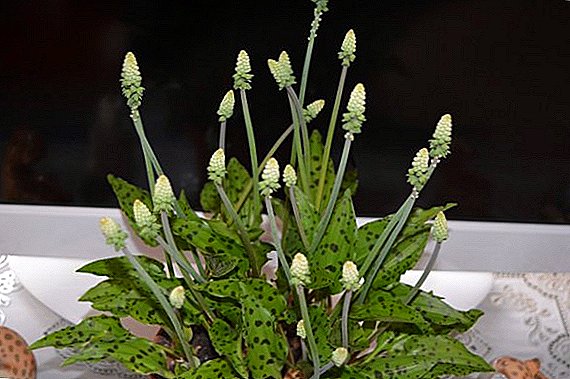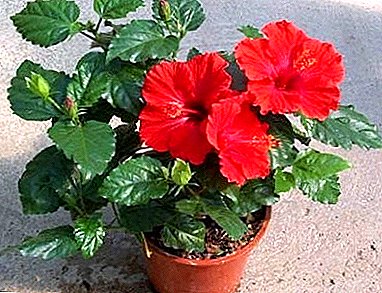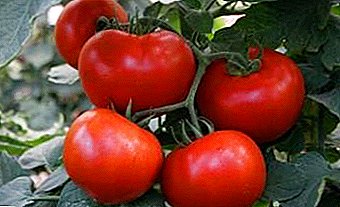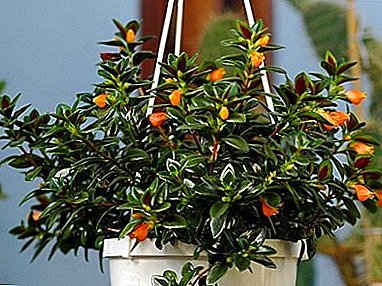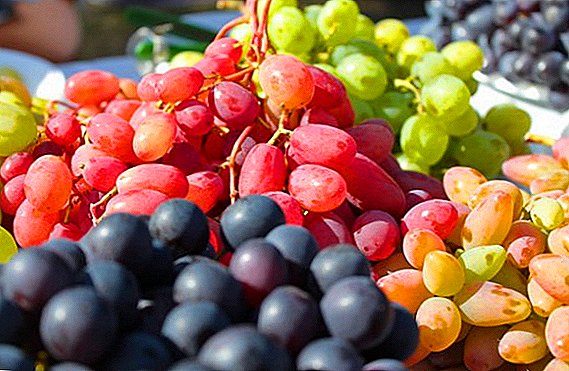 Grapes are one of the most common crops, the abundance of various varieties of which can not be counted.
Grapes are one of the most common crops, the abundance of various varieties of which can not be counted.
Each of us meets with a berry every day, since this product is widely represented in any category of food products, and eats it with pleasure. And special lovers of grapes cultivate this plant in their own summer cottage.
At a time when much has been written about representatives of warm and temperate climatic zones, winter-hardy grape varieties still remain in the shadow of their southern counterparts.
For the majority of grape lovers, it remains a mystery which winter-hardy varieties are most popular, which among them are notable for their high yield.
Taiga
Taiga - a universal grape, which has found its application in amateur and professional viticulture in the production of juices, compotes, jams and other food products.
True Taiga vocation is the raw material for the production of wine products. Bush with strong root system. The leaves of the plant are small, cut along the edges and divided into 3 separate lobes.
Did you know? The Northern grape is not a selection variety, since it has been growing in the Black Sea region and nearby regions since ancient times, after which it gradually spread throughout Europe.Berries are round, dark blue shades with a characteristic patina. The cluster is small, conical in shape, and its mass does not exceed 400 g. The ripening period is very short and does not exceed 90 days.
Grapes are able to tolerate freezing temperatures down to -32 ° C. Taiga is one of the most fruitful varieties, since the average yield per bush reaches 100 kg. 
Blue north
Blue Northern refers to table varieties of early ripening with a high degree of frost resistance. With favorable conditions for fruit ripening is not required more than 115 days.
Learn more about such varieties of table grapes as "Talisman", "Augustine", "Sensation", "In Memory of Negrul", "Talisman", "Kesha", "Victoria", "Zabava", "Extra", "Moldova", " Lancelot, Rumba.Bushes at Blue Northern voluminous, new shoots grow quickly, which makes it possible to use the grapes as an ornamental landscaper in the summer cottage.
The leaves of the plant are small, cut along the edges and divided into 3 lobes, on which are characteristic setae below. This vineyard blooms profusely, flowers are exclusively for women.
The grapes ripen small in size, in most cases medium-sized and have a conical shape. The berries have a regular round shape, blue in color with a characteristic pale bloom. The yield of the north is about 80 kg from one bush. 
Muromets
Muromets is a strong-growing grape variety with a short ripening period (about 115 days). XThe characteristic feature of the bush is the flattening of the main shoot in the lower part and the abundant growth of secondary shoots.
The leaves are large and medium sized, with 3 or 5 lobes. The clusters are large, regular conical shape, weighing about 500 g.  The berries are also large, have a slightly oval shape. The fruits are dark purple hues, which is hidden behind a rich wax bloom.
The berries are also large, have a slightly oval shape. The fruits are dark purple hues, which is hidden behind a rich wax bloom.
The grapes are bred for fresh consumption, but they make excellent raisins in taste. The yield of Murom is average, each fruit-bearing shrub is capable of producing about 15 kg of fruit.
Did you know? In order to protect the vine from pests, it is necessary to sow parsley under the bush.
Pearl pink
Pink pearls have proven to be a versatile frost-resistant grape with early growing and ripening periods that do not exceed 115 days.
A distinctive feature of pink pearls is the high resistance of the plant against fungal diseases and dangerous pests. The leaves are medium in size, in most cases with 3 lobes.
The clusters are not large, conical in shape and weighing no more than 500 g. Berries are round in shape, light pink in color. The yield of one bush on average is 7 kg, well, the number of ripe fruits reaches 95%.  The grade is recommended for the use as fresh, and for preparation of raisin and wine.
The grade is recommended for the use as fresh, and for preparation of raisin and wine.
Important! Despite the fact that pink pearls are unpretentious to the conditions of habitat, good agricultural technology is important for him, without it, the yield drops significantly.
Muscat Russian
Russian Muscat is a table grape variety that is suitable both for fresh consumption and for technical use. The shrub is of medium growth power, which can be quite effectively stimulated due to abundant irrigation.
The leaves are medium in size, characteristicly dissected into sections. The period to the full ripening of the fruit is about 115 days. The cluster is small, sometimes conic lobed, and its average mass reaches 300 g.
The berries are juicy with a bright nutmeg flavor, regular round shape, dark blue with a slight waxy coating. The variety is resistant to many fungal diseases. 
Kishmish Niagara
Kishmish Niagara belongs to the highly productive seedless technical varieties of American breeding, which are cultivated solely to obtain rich taste qualities of wines.
The lamina is medium or large, divided into 3 or 5 blades, with slight pubescence on the lower part. The crop ripens early, for no more than 100 days.
The clusters are large, but they are medium, cylindrical or conical in shape. The berries are large in size, oval in shape, in a palette of soft greens with a slight yellowness. A distinct trait of the variety is low acidity of the juice.
Productivity is high, frost resistance is average and reaches no more than -22 ° С. Kishmish Niagara is resistant to mildew, however, with the abundant development of the pathogen, the plant may be affected by the disease.
Important! When cultivating the Kishmish Niagara cultivar, it is important not to forget that the plant prefers rich soils, but poorly develops on the poor, which will have a negative impact on the future harvest.

Kishmish Jupiter
Kishmish Jupiter is a table seedless seed of American selection with a short ripening period, which does not exceed 125 days. Shrubs in most cases, medium in size, but there are large-sized specimens.
The lamina is medium in size, divided into several blades. The bush is characterized by excellent rooting, which allows it to begin to bear fruit after 2-3 years. The flowers are bisexual, so the plant is perfectly pollinated regardless of habitat conditions.
The clusters are cone-shaped, small in size and weighing up to 250 g. The berries are rather large, oval in shape and slightly oblong, of dark blue shades with a slight pale bloom. The grade is kept well that allows to transport fruits for a long time. 
Kishmish Venus
Venus sizzle is a seedless table grape that does not require hiding, up to a temperature of -30 ° C.
In addition to food destination, the plant is actively used for decorative purposes, as it is one of the few vineyards that is ideal for decorating outdoor arches and arbors.
Venus refers to the early ripe grapes (the ripening period is not more than 120 days). The strength of the shoots is average, but in optimal conditions may increase. Clusters of plants of medium size and weight not exceeding 400 g.
Their shape is cylindrical, with a pointed end. The berries of Venus are round, regular shape, dark blue. The yield is above average. The plant is unpretentious to the habitat conditions and resistant to many fungi and parasites. 
Kishmish Spartan
Spartan Kishmish is a seedless table variety that belongs to superearly grapes. As an uncovered frost-resistant variety, grapes have proven themselves in Ukraine, where, under severe conditions, it is able to withstand a temperature drop to -35 ° C.
The ripening period of the fruit does not exceed 100 days. Bushes are characterized by shoots with a large growth force and a middle leaf, dissected into sectors of regular shape. The cluster of a plant has a medium, large cup and a cone-shaped shape, and their weight is on average about 1 kg.
The berries are round, large, green-yellow shades. The flesh is especially juicy, with a slight nutmeg flavor. Under optimal weather conditions, the plant bears excellent fruit.
Important! If you decide to plant Kishmish Spartan on your own plot, remember, after full ripening, the fruits must be collected in a short time, otherwise they can instantly crumble.

Louise Swenson
Louise Swenson refers mainly to technical wine grapes with an average ripening time (about 125 days). The plant belongs to the best derivatives of breeding in the United States, where in 2001 it became the variety of the year.
The shrub reaches medium size and is characterized by moderate growth force. The leaves are dissected into 3 sectors and have small cloves along the edge. The cluster is a regular conical shape, medium size.
The technical grapes also include: "Alpha", "Krasnostop Zolotovsky", "Isabella", "Chardonnay", "Cabernet Sauvignon", "Riesling".The berries are small, round, green-white shade. The bush fructifies plentifully for more than one year. The variety is especially popular due to frost resistance down to -40 ° C, easy maintenance and 100% resistance to any plant diseases and infections.

Marquette
Marquette is deservedly considered one of the most promising and new varieties of US breeding. It combines increased frost resistance (up to -38 ° C), resistance to many diseases and improved taste characteristics.
Variety refers to the technical grapes, the fruits of which are widely used in winemaking. The bush is of medium vigor, the leaves are predominantly three-toed with small teeth at the edges. Fruit ripening averages do not exceed 120 days. Clusters of regular cylindrical shape, weighing about 400 g. The berries are round, medium in size, dark blue in color, but often almost black.
The yield is high, reaching about 100 kg per 1 square meter. plantings. The fruits are used exclusively in industrial winemaking. 
Frontylak
The frontallach is a technical variety, mainly of middle and late terms of ripening of fruits (about 140 days). The bush is characterized by a high force of growth and development, as a result of which the seedling will bear fruit already 3 years after planting.
Clusters of medium size, cylindrical shape, can be long on the bush without shedding. The berries are regular spherical shape, small in size, dark blue, almost black in color.
The plant is excellent fruit and resistant to most fungal diseases, even in a period of high humidity, and also requires almost no additional care and watering. The fruits are used mainly in large-scale production of wine.
Did you know? In order to increase the yield of grapes, it is necessary to trim it in time and give the bush the correct shape.

Adalmina
Adalmina is a predominantly wine grape variety. Ripening period is about 115 days. The strength of the shoots is average, the leaves of the correct three-blade form, which makes it possible to grow the vineyard as an ornamental plant on the arches or arbors.
The cluster is average in size, and its mass does not exceed 120 g. The berries are small in size, round, with a full ripening of a green-golden hue. The plant is resistant to most causative agents of dangerous diseases and bears excellent fruits.
In addition, Aldamina is able to withstand temperatures as low as -35 ° C without special hiding. Wine drinks from this variety are characterized by fruity aftertaste with light notes of citrus.
Frost-resistant grapes are an excellent choice for both temperate and southern climates, as they are able to withstand most of the extreme weather conditions and are unpretentious in content.
Despite its agricultural value, the correct elegant form of leaf and shoots of most members of the group is an excellent solution for decorating the site.  Winter-hardy vineyard is the best plant for summer cottage, which will give not only tasty fruits, but also improve the site with its appearance.
Winter-hardy vineyard is the best plant for summer cottage, which will give not only tasty fruits, but also improve the site with its appearance.


